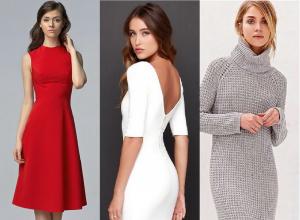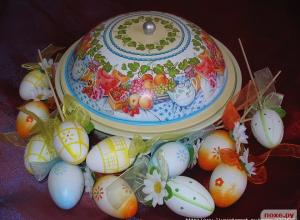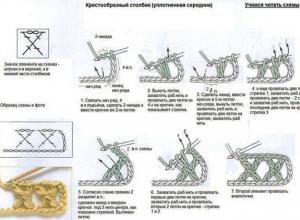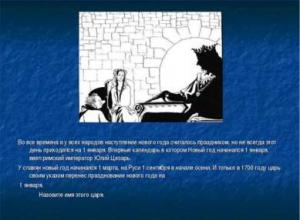Patterns for youth dresses. Dress pattern for a business woman in a sporty style
Ready-made dress pattern for a business woman.
Dress with reliefs and yokes, pockets and sleeves at the cuffs.
There is a placket fastening in the middle of the front (loops and buttons). The plank ends with a counter fold. At the waist there is a small decorative belt with a buckle. On the shelf, the line of vertical relief turns into the line of the pocket. Turn-down collar. All details are stitched with a finishing stitch, emphasizing the cut lines. The length of the dress along the back is 102 cm.
You can adjust the length of the dress, as well as the length of the sleeves, yourself, choosing the best option for yourself.
The pattern is given in actual size without seam allowances.
- Bust 96
- Waist 80
- Hip circumference 104
Preparing the pattern for work is simple. Download, print the pattern sheets on a regular printer and connect them according to the diagram. The pattern is the order in which the pattern sheets are connected. It is printed on the first sheet.
Be sure to check the scale for consistency. On a printed sheet with a 10x10 cm square depicted, sides of 10 cm should correspond to exactly 10 centimeters. To do this, in the printer settings, set the document print scale to 100% (no scaling).
Ready-made patterns are given for a conventionally typical figure. If your figure differs from the conventionally typical one, you should adjust the pattern taking into account the characteristics of your physique and only then start cutting.
Don't forget to give seam allowances, as well as additional allowances in those places where clarification is possible during fitting.
Having swept away the parts, try on the product, make all the necessary adjustments and start sewing.

For those who want to create a pattern for a specific figure according to the measurements taken, we have a detailed step-by-step instructions for constructing the base of the dress semi-adjacent silhouette.
Download the pattern >>>
For the hardworking - a bright light burns through life, for the lazy - a dim candle
Constructing a base pattern - THE MOST CLEAR METHOD (for beginners)
visibility 917872 views
Good afternoon I would even say a beautiful day. Because we are finally starting a series of articles on tailoring for adults. We have already sewn a lot of things for little girls - both dresses and bodysuits are different - now we will sew for big girls. That is, for myself. And since you and I have already practiced sewing, the fear of the pioneer has passed.
THAT MEANS IT'S TIME TO TAKE A NEW FRONTIER. And master the wisdom of sewing using real adult patterns yourself, with your own hands and your own brains. We will draw the base pattern ourselves - in a new, easy way (I spent more than one week creating this lightweight method for creating a base pattern). And then we will sew a bunch of all kinds of dresses, tops and tunics.
No- I won’t give you a single finished pattern!
I'm not Madame Burda. I am Madame Klishevskaya.))) And the main harmfulness of my character is... That I will make your head work and give birth to bright and clear discoveries in the field of sewing. The easiest and most understandable of all types of art. Believe me, this is true.
Yes- sewing yourself is very easy and simple!
Right from scratch you will get more and more beautiful and well-tailored things.
Moreover, you will do everything yourself, without a state of hypnosis, but in a sober mind and clear memory. YOU will DO it - moreover, you will UNDERSTAND what exactly you are doing.
I will tell you the secrets that I know. Moreover, I will teach you to discover more and more secrets of the world of sewing and clothing design.
I will not lead you (blind and stupid) by the hand in the chaos of letters and numbers denoting the intricacy of numerous lines of the design drawing. NO, I WILL NOT TAKE YOU HERE:
Well, you must admit, one such picture can instill fear and make a girl who doubts her own abilities really, really wants to sew a dress- But I wasn’t very good with geometry and drawing during my school years. Even I, who adore both of these school subjects, beat around the bush for several years, not daring to start delving into the construction of such a drawing: “How long will it take to draw something like this, and after all, everything must be calculated correctly and not get confused in the letters...”.
And, nevertheless, today we will draw a pattern.
We will draw a base pattern (you see a piece of it from above.))))
But - don’t be afraid - we will create our pattern a little differently. Away from the engineering design method - and closer to human understanding.
We will draw one for you - just one- pattern.
And then from it we will create more and more new dress models. And it will be very easy and simple.
- No confusing formulas
- No confusing calculations.
- And without the letter-number cobweb.
So how? Have I already alleviated some of your concerns?
I'll relax now - we won't start drawing right now. First, we'll take a nice walk through the pattern. The purpose of the walk is to get to know and become friends with the pattern and remove the last doubt that you can sew any dress.
So... what is a pattern - the basis?
To put it figuratively, this is a cast of your body. This is your individual imprint. Any item sewn according to YOUR base pattern will fit YOUR figure perfectly.
Yes, you heard right - ANY THING can be sewn on the basis one single pattern. All dress models are born, modeled, and sewn from one source - this is the base pattern.
I will now prove it to you with an example. Even with three examples - in the form of photos and pictures.
Here is the first photo (below). Our pattern base is essentially your sheath dress (the one that fits your body perfectly). Dress made by yours pattern base, will follow all the curves your his bodies. This simple sheath dress is sewn using a regular base pattern. You see, it’s like a plaster cast of a girl’s figure.
And today, having drawn the base pattern, you can safely cut it on the fabric - and you will get a dress like this. The only thing you can change is the neckline - giving it the shape that suits your face shape.
All other (any kind) dress models are just a modification of a sheath dress - fantasies on a free theme.
That's how it works in the fashion world.
One day a fashion designer thought...“What if the bodice of the dress at the top is held on the shoulders by a round yoke (yellow outlines - figure below), and the bodice itself is made in the form of overlapping intersecting triangles (red outlines - figure below). The result is what we see in the photo below.

Beautiful? Beautiful! What did the fashion designer base his fantasies on? Based on a pattern. And you can come up with something of your own. We women have just a lot of imagination.
By the way - since we’re talking about a round yoke here - this site already has one of my articles on creating and
And another fashion designer thought: “What if you give the sheath dress a looser cut - make it wider. And make the shoulder line longer so that it hangs over the arm.” And as a result, a new model is born (photo below) - also very beautiful. And it's very simple.
You can do this too. If you will UNDERSTAND what the base pattern consists of. And by what laws does it exist?
That is why I don’t want to stupidly give you instructions on creating a base pattern (like “draw a line from point P6 to point P5 and mark the place where it intersects line X with the next point...” - ugh!).
I want to awaken you bitch. I want you to feel the pattern, to know its soul. Haven't learned to see what a simple drawing hides behind a photograph of any dress, even an intricately tailored one.
Therefore, for the next 30 minutes we will not draw anything - we will walk through the pattern itself. Let's get acquainted with all its elements - find out what each line serves, and why it is located here and drawn this way.
After such an “educational walk” you will feel a joyful clarity of understanding of everything, everything, everything. It's as if you've already drawn basic patterns many times. And you will take up the drawing with the feeling that this is a couple of trifles. Ha! Business!
As the sage said: “We are afraid only of what we cannot understand and explain logically. But as soon as the thing that frightens us becomes clear to us, it ceases to cause us fear.”
So let’s go and tame this “terrible beast” - the base pattern. Let's tame and draw in 20 minutes. Yes, yes, in 20 minutes - because after a walk - the pattern drawing will seem to you an old and familiar simple drawing - like a grid for playing tic-tac-toe.
Where does the base pattern come from?
So where does the base pattern come from - usually it is obtained from the following drawing:
The drawing contains half of the back part + half of the front part.
We will also draw a similar drawing with you - only more simple and understandable.
And what these halves are needed for, and where to use them - now I will clearly show everything.

Here (!) I dug up a wonderful sample - below - in the photograph of a black and white dress, our halves are very clearly visible - both the back half and the front half. So to speak - clearly and understandably.
Yes, in the Potnovian language the halves are called “shelves”. Today we will draw these same front and back shelves. But first, let’s take a closer look at what elements each shelf consists of. And most importantly, I will tell you why each element is needed and what it serves.
To make everything as clear as possible, I will illustrate each of the elements both in pictures and in photographs of real dress models.
First, let's get acquainted with two incomprehensible words: DOT And ARMHOLE.
Of course you may know them. Or maybe not. My job is to introduce you.
So, meet - PROYMA
When drawing a base pattern, you will create exactly that bend and size armhole that suits you – when the armhole does not pull or dig into your arm.
That is, the pattern base contains minimum armhole size allowed. You can model the armhole to your taste, in any configuration. But your fantasy armhole should not be smaller than on the base pattern. That is, the armhole is based on a pattern - These are the boundaries beyond which your imagination should not cross.
Your model armhole can be as large as you like - but it cannot be smaller than on the base pattern. More - yes, less - no - otherwise it will dig into the armpit. This is the rule in modeling designer armholes.
Now let's get acquainted with the darts.
BACK DARTS – shoulder dart + waist dart
In the picture above, I wrote everything about the back darts - and in the photo of the dress you can find 2 waist darts - one to the right of the zipper, the other to the left of the zipper.
But you don’t see the shoulder dart on this dress. And many dresses don’t have it either. Because for convenience and beauty, this dart is moved from the middle of the shoulder to the zipper (or along the edge of the armhole, where the sleeve will be, a corner is simply cut off). That is, the excess fabric is not pinched at the middle of the shoulder and is not sewn inside the dart. And the extra fabric cut in the form of a corner at the edge of the shelf, where the zipper is sewn in, or at the edge of the armhole - where the sleeve will be sewn in.
Also, darts are not necessary if you sew from stretch fabric - it itself follows the curves of your body and shrinks both in the shoulder and waist areas.
Let's get to know each other next... DARTS ON HALF FRONT
Oh, I could write a whole poem about her.
I spent a long time wondering how to explain more clearly - why it is needed and by what laws it lives. I thought and thought... and came up with an idea.
The fact is that a woman has breasts.))) That is, from the front, an adult girl is no longer flat. This means that the dress should be convex in the chest area. The dart on the front shoulder gives the dress that same bulge in the bust area. Now I’ll show you everything in pictures. How does this happen.
For example, we have a flat piece of fabric, but we need to make a convex piece out of it. To do this, you need to make a tuck on it. For example, this flat circle of cardboard will now become convex with the help of a dart.
And here's how a bust dart creates a bulge on the front detail
You will notice that the top of the convexity (that is, the peak of our round pyramid) is at the tip of the dart. Pay attention to this. Because when we draw the bust dart, the point of our dart will be at the top of the chest(where the nipple or bra cup is usually located).
Remember that sometimes you tried on a dress in your size in a store, which somehow strangely skewed on the chest - this is because the dart in the dress with its point was directed by the tops of your chest. So the breasts did not fit perfectly into the bulge of the dress. This product was not cut at the factory to suit your breast shape.
But that is not all, what I want to say about the chest dart.
The fact is that in almost all dresses this chest dart is located not on the shoulder- A on the side just below the armpit. This is done for beauty. The dart on the shoulder catches the eye more, but on the side, and even covered by the hand, it is not noticeable.
When creating a base pattern, we draw a chest dart on the shoulder only because it is more convenient to draw there from the point of view of constructing a drawing.
And after the drawing of the base pattern is ready, we very easily and simply transfer the dart from the shoulder area to the armpit area. Don’t think that you need to make new drawings for this. Nope, everything is simple here - like opening a carton of milk - one minute and that’s it.
Here, in the picture below I schematically depicted transferring the bust dart from the shoulder to the side seam under the arm.
Well, do you already feel how wiser you have become in these 15 minutes?))) Or there will be more... Let's continue our walk through the pattern and now let's get acquainted with the lines. Horizontal lines
CHEST LINE
The first acquaintance is the chest line. (It’s a beautiful dress, isn’t it? We’ll make it for you. Don’t even hesitate)

The bust line is the most remarkable line on the pattern. It is so convenient to focus on it when drawing a base pattern because:
- We know that we finish drawing the back waist dart at the bust line.
- We know that we finish drawing the front waist dart not reaching 4 cm from the chest line.
- We know that the shoulder dart is in the front - we finish drawing it at the chest line.
- We know that the lower edges of the armholes also follow the bust line.
Well, no, of course, you don’t know that yet. I will give all these simple rules when we start drawing. And now I just want you to know that when drawing many elements of a pattern, you can simply focus on the chest line (and there is no need to painstakingly put down these letter-number dots).
As you can see, there’s a lot of everything!! Therefore, go ahead - study, sew and enjoy life)))
WHAT TO DO NEXT - WITH THE PATTERN BASE? - you ask
And we will start sewing according to the base pattern of the TOP. Namely tops, T-shirts, tunics and then dresses.
You might ask, “Hey, why not just dresses?” I give the answer to this question in the first article of the series. So to be continued)))
Happy sewing!
Patterns for women's dresses from the Grasser bureau
A dress is the type of clothing that can best highlight the beauty of a woman’s figure. Especially if such a dress is sewn individually. The GRASSER online store offers simple dress patterns that will be of interest to both beginners and experienced seamstresses. In our catalog you can choose patterns for a wide variety of models and for different female figures. Such patterns are created by true professionals from our clothing design and modeling bureau. This ensures that you will encounter minimal complications or problems when sewing your dress.
Advantages of purchasing a ready-made pattern from our bureau:
- The pattern is made for a specific size (from 38 to 54);
- We offer patterns of modern dress models, inspired by fashion shows;
- The pattern comes with an accessible description with diagrams and instructions;
- All dress patterns can be purchased at a very low price.
It’s easy to sew a dress using a pattern!
Even if you are new to tailoring, with a ready-made pattern, the entire process of creating a dress will not take you much time. It is very convenient that all patterns are designed for printing them either on a regular printer on A4 sheets or on a wide-format plotter. Immediately after paying for the order, you will receive your pattern in PDF format, which you can download from your personal account. Using our simple patterns, you will get real pleasure by creating an original new thing for your wardrobe.
Latest site materials
Cosmetology

Midi dresses Beautiful midi dresses
The classic model of dresses of medium length is called “midi”...The classic model of dresses of medium length is called “midi”, and it should be in the wardrobe of any modern beauty. Midi dresses look elegant and formal, so they would be appropriate
Cosmetology

Interesting facts about Easter Briefly interesting facts about Easter
The egg is the main symbol of Easter, which means new life and rebirth for Christians. That is why it is an obligatory element of many Easter customs and games. The custom of giving each other colored eggs was not invented by Christians. This is what they did before
Experience

Embossed crossed crochet stitches in patterns for blankets, bags, pillows YouTube how to crochet a crossed double crochet
Crochet pattern - crossed columns. Different, different types of crossed columns. They are often used in Vanessa Montoro's vintage dresses, which is of particular interest to me. I think it’s not just me. Therefore, it’s time to knit dresses based on Vanessa Mo
Health

Mental development of a preschooler About the mental activity of preschoolers
PAGE_BREAK--The use of spatial models also turned out to be extremely effective when teaching preschoolers to analyze the sound composition of a word.
Horoscope

Lesson from the world around us
Lesson about the world around us "winter holidays" Winter New Year
Health

Outline of the world around us Topic: Winter holidays Purpose: to introduce the common and different features of the Christmas holiday in Western countries and Russia (past and present), with the origin and features of the winter New Year holiday Pl
Two children and a frozen pregnancy: will you be able to give birth this time?